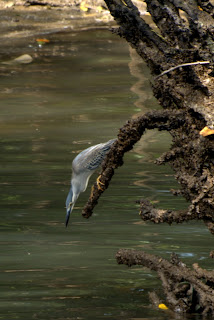At the entrance to the reserve, the handsome Common Moorhen (Gallinula chloropus) (my lifer..although I know it can be commonly seen at that area in SBWR) was pecking into the water occasionally as it walks. With its bobbing head and flicking tail, I tried for a long time before I managed a less than satisfactory photo of this Rail.
On a nearby tree, a male chubby Pink-necked Green Pigeon (Treron vernans) showed off its colourful coat....
while the female watches in awe...
A few Yellow-vented Bulbuls (Pycnonotus goiavier) were gleefully chasing each other in flight. This posey one perched on a nearby branch, and gamely showed off its Mohawk hairdo to a few cameras, including mine. A common resident throughout the island, they have adapted to the cultivated environment and has a wide ranging diet of plants and animals.
At the main bridge, I couldnt help following the rhythm by the male Common Flameback Woodpecker (Dinopium javanense) as it pecks on the tree trunk.. kok kok kok kok kok. Although this is a common resident, this is my second lifer of the day!
The Grey Heron (Ardea cinerea) was also enjoying a hearty breakfast by the river bank. This hunter can stab quickly at a prey in the water with its special kink in the neck, and typically swallows its prey whole, thus it has a strong and efficient digestive system. A top predator in the ecosystem, presence of a healthy number of herons are good indicators that our wetland is healthy. Nonetheless, these majestic birds are threathened by loss of habitat locally.
I used to think that the Striated Heron (Butorides striatus) a.k.a Little Heron has a really short neck as I often see it in its usual egg-shaped stance, until I witness one in hunting action. Looking intently at the water for its meal, it can also stab quickly at the prey by extending its neck. This is apparently one smart bird that knows how to use a bait to fish. A solitary bird, they usually hunt alone and are highly territorial.
Listed as a vulnerable species in the IUCN list due loss of coastal habitat and excessive hunting, the Milky Storks (Mycteria cinerea) that we see at the reserve are unlikely to be wild ones. This individual was pacing up and down, dragging its slightly opened bill in the water to feed. It was quite a joy to watch it raise one wing intermittently, probably to stir prey movement.
I have to try and find time to visit the reserve again, else I'll have to wait for 6 months before meeting the migratory birds in September again.










No comments:
Post a Comment